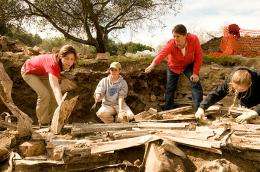Excavation unravels mysteries of men's gymnasium's demise during 1906 earthquake

More than a year into an excavation project of the men's gymnasium that was destroyed by the 1906 earthquake, Stanford university archaeologist Laura Jones' team has unearthed evidence suggesting why the newly complete building collapsed so spectacularly while so many other structures survived the violent temblor.
Laura Jones, director of heritage services and university archaeologist, her students and a group of volunteers spent much of the past year excavating at the site of the former Men's Gymnasium, which was destroyed during the 1906 earthquake before it ever opened. Located on Lasuen Street at the corner of Campus Drive near the Frost Amphitheater, the site will soon give way to the Bing Concert Hall. Before construction begins, however, Jones has been leading an excavation into what is left of the gymnasium. Had it survived, the three-story, Greek-columned building would have been the largest gym in the United States at the time.
Jones and her students have been exploring what's left of the building, uncovering artifacts from the rubble and puzzling over why it fell so spectacularly. She answers Stanford Report's questions about the excavation and future plans for the site. Visit the dig website for more information.
Q. What of note did you find during the excavation?
A. While there are a few areas where demolition of the footings was attempted and abandoned - these are truly massive chunks of concrete - we found that the footings are surprising complete. The physical features of the building footings had some remarkable features. For example, while the footings themselves are concrete and 6 to 10 feet deep, there appears to be no metal reinforcing the concrete. Instead, the builders inserted "bearing stones" - solid granite blocks nearly 4 feet in width and 2 feet deep - and attached iron columns to these granite blocks with shims and grout.
It is surprising, given that the Museum had been built in 1891 with reinforced concrete, that this simple notion of anchoring the metal in the concrete is absent in a building built more than a decade later.
There are a number of interesting artifacts that have been recovered from the site, but they are what we would expect from a building that collapsed during construction: tools and debris generated by the workers who built the building and demolished it. These include beverage containers, tobacco tins, nails, buttons, bits of animal bone and other sundry items of turn-of-the-century working life.
Q. Do you get the impression that the gym - especially the pool - was a dumping ground for earthquake residue?
A. Once the decision was made not to rebuild the gym, the swimming tank was an extremely convenient place to dump rubble. It was one of many sites on campus filled with debris. The debris represents materials from more than one building. There is a large contribution of rubble from the collapsed wings of the Stanford Museum. We know this because of the distinctive metal clathri windows and molded concrete exterior materials that were only used on the museum building. We're working on documenting the process of disposal. We think we can identify individual wagonloads, the sequence in which they were dumped and where they came from. This will be major step forward in future excavations addressing other 1906 dumps, several of which are still intact on the campus.
Q. Do you know why the gymnasium collapsed so spectacularly, while other buildings weathered the earthquake?
A. It seems that the large rooms in the upper floors - the gymnasium itself, the ballroom, the large open atrium in the center - provided very little support for the huge roof and dome. The massive sandstone columns on the front façade appear to have rocked forward, pulling the dome down and tearing the roof apart.
The brittle materials - stone, brick and cast iron - poorly anchored to each other must have also contributed to the collapse. The Quad buildings, for example, were composed of many smaller rooms with wood-framed interior walls, and they seem to have held up better than the buildings with large public spaces and giant open roof spaces such as Memorial Church, the Library, the Museum and the Gym. The engineers of the time faulted the composition of the mortar and concrete and the design of the roof trusses, but we really need a modern structural engineer for a complete analysis of the failure.
Q. A lot of students worked on the site. What did they learn?
A. They learned the basic skills of archaeological investigation: sampling strategies, excavation techniques, problem solving and teamwork. They also learned a lot of history - about architecture and construction practices; views of health, hygiene and sports from the period; about technology, labor practices and university decision making. They learned to pose hypotheses, question their assumptions, speculate wildly and evaluate evidence. This kind of hands-on research experience is absolutely critical to our archaeology majors, and I'm sure it's good for the students who decide to go in another direction as well.
Q. What is in store in the future for this site?
A. Katrinka Reinhart and I will be teaching out there again winter quarter. Then in spring, the contractor will arrive to begin demolition of the footings in preparation for construction of the concert hall. We'll be monitoring the demolition closely and expect more surprises as the project begins. We'll be writing up our findings in a report and looking for opportunities to do a temporary exhibit, as well showing some of the materials we've found.
Provided by Stanford University (news : web)


















